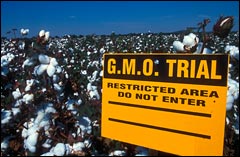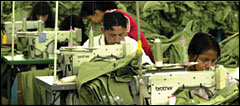The view from the Panoche Cotton Gin outside Firebaugh, Calif., reveals a great deal about the state of the cotton industry in the U.S. A generation ago, fields of cotton surrounded the gin as far as the eye could see. Today, the gin — a warehouse-sized plant that can clean and bundle dozens of tons of cotton a day — is flanked on all sides by almond orchards, groves upon groves of the tall trees.

An endangered species?
Photo: iStockphoto
“Cotton used to be king — it was our No. 1 crop,” Joseph Maron, the operations supervisor for the gin, told a group of visitors on a bright autumn day. “Now it’s all pistachios or almonds. The cotton industry is slowly disappearing.”
Quickly disappearing may be more like it. This year, California farmers are growing about 550,000 acres of cotton — a decrease from just two years ago, and a sharp decline from a historic peak of 1.5 million acres. Growers expect the number to drop to less than half a million acres in the next few years. The number of cotton gins has also plummeted. There used to be more than 100 gins in the San Joaquin Valley; now there are half that many.
Why are cotton planters facing a state of collapse? For the same reason that soy farmers, tomato growers, and apple orchards are struggling: international competition. It’s simply cheaper to grow cotton in Pakistan, India, or Turkey than it is in California, Arizona, or Texas.
The globalization of agriculture is certainly bad news for growers who have never known anything except cotton. It’s also troubling for the advocates who are spearheading a campaign for organic and low-spray cotton. As they promote a way of clothing ourselves that doesn’t involve stripping the earth naked, backers of sustainable agriculture are finding that the economic imperatives of a global economy are making their work harder than they ever expected.
“The market for domestic organic cotton has completely disappeared, because the price of overseas cotton is half as much,” says Marcia Gibbs, program director of the Sustainable Cotton Project. “If you were a farmer, you’d be a fool to grow organic cotton if you weren’t sure you’d get a living wage for your work. We’re seeing a big increase in people interested in organic cotton, but we’re not seeing people step up to the plate with their pocketbooks.”

How does your cotton grow?
Photo: iStockphoto
It’s In the Jeans
Cotton is one of the most chemical-dependent crops, with conventional growers using a battery of herbicides and pesticides to control weeds and insects. Most cotton fields — at least 70 percent in the U.S. — are also genetically modified, as farmers come to depend more and more on Roundup Ready seed. The reliance on chemical inputs has been blamed for a range of problems, from water contamination to unusually high cancer rates.
In an effort to reduce the environmental impacts of cotton production, the Sustainable Cotton Project tries to enlist farmers in a program to convert to organic. But it has been a tough row to hoe. Nationwide, there are no more than 12 organic-certified cotton growers, according to the Organic Trade Association. In California, there are just two — and that’s double from a year ago.
The effort is greatly complicated by the fact that cotton — a gangly, four-foot shrub whose flower forms the downy fiber manufacturers prize — needs to drop its leaves before it can be mechanically harvested. Otherwise, the green leaves can stain the cotton, and make it wet and susceptible to mildew. The most common way to pick cotton, then, is to first spray a chemical defoliant on it — hardly an organic solution. Organic cotton growers in Turkey and Pakistan often pay people to handpick the bolls, and don’t use defoliants, but that’s not a viable option in the U.S.
“We can’t compete with a grower that has low labor costs,” says Frank Williams, a co-owner of Windfall Farms I in Firebaugh. This year, Williams and his brother-in-law grew 40 acres of organic cotton on their 1,300 acres, and they plan to quadruple that next season. But it’s a gamble for their business. “It’s economics,” Williams says. “All of our acres of cotton, I don’t know that we make hardly anything on it. There are other competing crops that make a lot more money. The only thing that saves us is the government subsidies.”
Since most cotton growers can’t take the risk of experimenting with how to harvest cotton absent chemical defoliants, advocates have set their sights on simply lowering, rather than eliminating, the amount of chemicals used in cultivation. A program run by the Sustainable Cotton Project called BASIC — biological agricultural systems in cotton — encourages farmers to quit GM seeds and adopt more sustainable practices such as composting, cover cropping, and organic pest management. In 2006, some 1,200 acres of cotton are being grown under BASIC guidelines.
Though still in an initial stage, the BASIC program is already turning heads. Sustainable-agriculture advocates have been impressed by pesticide reductions as high as 73 percent. And farmers like BASIC cotton because they have found they can maintain their yields while cutting the amount of money they spend on chemical inputs.
Stanley Silveira is one farmer who has been busy telling his neighbors about the benefits of BASIC cotton. A longtime farmer and professed evangelical Christian, Silveira cheerfully compares his adoption of low-spray techniques to his religious conversion.
“God created everything,” Silveira, a round fellow with a crown of silver hair, says. “There is a wisdom in the natural world, and hopefully we can be wise stewards of the way God planned it. We don’t want to upset the balance. If we can get the same yields, and the same quality with less inputs, and it’s better for the environment — that just makes sense.”
But even if farmers can perfect ecologically sustainable methods for growing their cotton, they still face the challenge of developing economically sustainable ways for growing their sales. The biggest hurdles for maintaining a healthy cotton industry are business-oriented, not biological.
Boll Evils
To stick with organic and low-spray cotton, farmers say they need a commitment from apparel companies to make steady, yearly purchases of sustainable harvests. But the apparel industry is loath to make concrete promises to buy domestic cotton when organic cotton from, say, India sells for less.
The reluctance of companies to commit to U.S. organic cotton was on display during a recent tour of California fields sponsored by the Sustainable Cotton Project. With two buses packed full of fashion industry executives from popular brands such as Levi Strauss and Prana, the tour was intended as a way to show off the potential of sustainable cotton. But while all the apparel executives seemed genuinely interested in using more organic cotton in their clothes, none was prepared to make a public promise to buy more American-grown fiber. The economics simply don’t add up.
“We’re concerned about the impacts of chemicals, and the health of everyone along the supply chain,” says Erica Bloomenthal, an executive with upscale clothier Eileen Fisher, which sells a line of organic cotton T-shirts. “But we’re in a global economy, and we can’t ignore that. The apparel business is a global business. We’re a design-driven company. We have to like what we see, and if we find a beautiful piece of Italian fabric, that’s what we’ll use.”

Offshore, you betcha.
Photo: state.gov
The challenge of supporting U.S. farmers is compounded by the fact that the domestic apparel industry has been, for all intents and purposes, dismantled. Most U.S. sewing operations were outsourced to Asia and Latin America long ago. And in the past decade, textile mills — which used to form the economic backbone of many southern states — have been offshored as well. Which means if a fashion company wants to buy American-grown organic cotton, it would likely have to send the fiber across the Pacific to be milled, woven into fabric, and sewn, and then ship it back across the ocean for sale in stores — not exactly the most sustainable scheme, given the petroleum involved alone.
Essentially, then, the way to get relief to cotton farmers would be to rebuild the U.S. clothing industry by reassembling a domestic supply chain of growers, mills, and sewing shops.
“A reliable supply chain is the biggest challenge in sourcing,” says Roian Atwood, director of community relations and organic programs at the trendy clothing-maker American Apparel. His company sells a line of organic T-shirts — made with cotton sourced from Turkey. “I think what we need is someone who wants to creatively invest in U.S. manufacturing. This is about the longevity of our economy, about realizing that manufacturing has to be part of the equation, that it can’t all be a service economy.”
So maybe supporting domestic, sustainable cotton production is less an issue of economics than a test of values. Do U.S. consumers value domestically grown, processed, and manufactured clothing? Is it important that the fiber keeping us warm is made closer to home? Or are we content with having all the clothes we wear be grown and sewn overseas?
“When I started my own company, I wanted to do it the most sustainable way that I could,” said Tierra Del Forte, founder of a boutique jeans brand called Del Forte Denim, as she stood next to a field of cotton ready to be harvested. “People are now getting much more interested in where their food comes from. That’s what I want to do with my business, to get people to think that their clothes come from somewhere, and that there are people involved every step of the way.”



